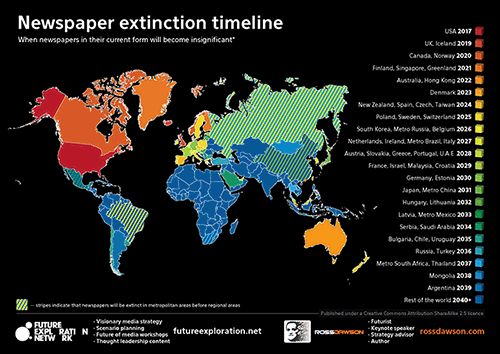Big moves at Fairfax: The global extinction of newspapers moves closer
Today’s ‘Fairfax of the Future’ announcement from Australia’s second largest newspaper publisher Fairfax is massive news in Australia, and very significant in a global media context.
It has been a busy media day for me, so far doing interviews for SBS World News and ABC24 News as well as a number of radio stations, due to my earlier predictions of the extinction of newspapers. My Newspaper Extinction Timeline was launched in October 2010, at the time getting mainstream media coverage in over 30 countries and being seen by well over 1 million readers within one week.

Click on image to download full framework
Recently I have been reconsidering some of the forecast extinction dates for a number of countries, notably after my recent European speaking tour. Fairfax’s announcements today significantly shift forward the likely loss of news-on-paper as a significant media format, and in fact make 2022 seem an exceedingly optimistic timespan for newspapers to survive in Australia.
Here are just a few of the important issues and perspectives emerging from Fairfax’s moves.
It is good to see bold moves but they come too late.
Given current revenue trends, debt levels, and emerging news alternatives, Fairfax has had to take dramatic action in order to survive. An over-extended desire to believe that existing news models could be maintained means that many opportunities have been lost to reposition the company.
A “digital first” policy suggests news-on-paper will quickly become niche.
Fairfax states it will have a “Digital First Editorial Model”. The announcement of closed printing presses and a shift to tabloid format is part of that shift. On the journey to eventually stopping printing their major mastheads, we are likely to see a weekend-edition only model. New Orleans Picayune-Times has recently shifted to printing three days a week. For Fairfax’s metropolitan titles, printing once a week would be sustainable for quite a few years. Other models where news-on-paper could survive are in highly regional publications, again often less frequently.
Paywalls have a better chance of succeeding in Australia than many other countries.
Because Australia is one of the most concentrated media markets in the world, where the largest player, News Limited, has already adopted paywalls for The Australian, there is a chance for Fairfax’s paywall plans to succeed in some form. There is no question Fairfax needs to try paywalls, and their intended approach of a metered, slightly porous model is most likely to work. This will allow them to experiment and see to what degree and for what content charging content is viable.
There are still opportunities for high quality, diverse news and journalism to flourish
There are far more opportunities in digital news than suggested by Fairfax’ and News’ woes. Their existing infrastructure, debt, mentalities, and news processes are massive liabilities in prospering in a very different emerging news landscape. Those unencumbered by that baggage can often compete well in a new landscape. Clearly a 20% cut in editorial staff from a major publisher has a significant impact on the number of front line journalists. While it is very unlikely that Fairfax will follow The Guardian’s lead towards “open journalism”, the reality is that traditional models of investigative journalism are not as good or as efficient as distributed teams including talented, experienced journalists and editors working with many contributors of insights. While the detailed shape is not clear, I believe we are shifting to a more diverse news and media landscape, where measures of the reputation of news outlets and journalists will allow voices beyond the traditional media brands to prosper.
News organizations ain’t dead yet.
Fairfax and its peers are in an incredibly tough position, and undoubtedly recognize it. However I believe we will have an even richer and more diverse news media landscape in years to come than we do today. While the large news companies of today have baggage in their debt, infrastructure, and mindset, they are still better positioned than anyone else to dominate the news landscape of tomorrow, if they act decisively. If they clearly recognize that news-on-paper is not the future and rapidly reposition for a very different news landscape tomorrow, they can still do well. It’s not (quite) too late.
